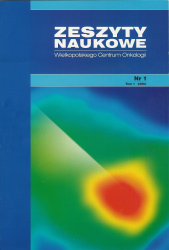Abstract
Hodgkin's lymphoma (HL) is one of the most common malignancies in young adults. The method of choice in the HL detection and staging is the positron emission tomography/computed tomography using the radiopharmaceutical
18F-flurodeoxyglucose (18F-FDG PET/CT) examination. The 18F-FDG PET/CT study has been considered useful in the evaluation of the treatment effectiveness. The HL therapy aims to cure the disease and ensure the lowest toxicity possible, thus, the detailed diagnostic management using advanced methods of imaging seems to be of value.
References
Bröckelmann PJ, Böll B. Moving things forward in Hodgkin lymphoma. F1000Res. 2018;7:F1000 Faculty Rev-1786.
Hoppe RT, Advani RH, Ai WZ, Ambinder RF, Aoun P, et al. Hodgkin lymphoma, version 2.2015. J Natl Compr Canc Netw. 2015;13(5):554–586.
Didkowska J, Wojciechowska U, Czaderny K, Olasek P, Ciuba A. Nowotwory złośliwe w Polsce w 2017 roku. Krajowy Rejestr Nowotworów, 2019. Dostępne na stronie: http://onkologia.org.pl/publikacje/ (dostęp z dnia 20.03.2020r.).
Aldinucci D, Borghese C, Casagrande N. Formation of the Immunosuppressive Microenvironment of Classic Hodgkin Lymphoma and Therapeutic Approaches to Counter It. Int J Mol Sci. 2019;20(10):2416.
Shanbhag S, Ambinder RF. Hodgkin lymphoma: A review and update on recent progress. CA Cancer J Clin. 2018;68(2):116–132.
Evens AM, Kostakoglu L. The role of FDG-PET in defining prognosis of Hodgkin lymphoma for early-stage disease [published correction appears in Blood. 2015 Apr 9;125(15):2450]. Blood. 2014;124(23):3356–3364.
England CG, Rui L, Cai W. Lymphoma: current status of clinical and preclinical imaging with radiolabeled antibodies. Eur J Nucl Med Mol Imaging. 2017;44(3):517–532.
El-Galaly TC, Mylam KJ, Brown P, et al. Positron emission tomography/computed tomography surveillance in patients with Hodgkin lymphoma in first remission has a low positive predictive value and high costs. Haematologica. 2012;97(6):931–936.
Ansell SM, Armitage JO. Positron emission tomographic scans in lymphoma: convention and controversy. Mayo Clin Proc. 2012;87(6):571–580.
Cheson BD, Fisher RI, Barrington SF, et al. Recommendations for initial evaluation, staging, and response assessment of Hodgkin and non-Hodgkin lymphoma: the Lugano classification. J Clin Oncol. 2014;32(27):3059–3068.
Agostinelli C, Pileri S. Pathobiology of hodgkin lymphoma. Mediterr J Hematol Infect Dis. 2014;6(1):e2014040.
Wróbel T, Puła B. Rozpoznawanie i leczenie chorych na Chłoniaka Hodgkina. Hematologia 2017; 8, 3: 163–176.
Piotrowski I, Kulcenty K, Suchorska W. Historia badań nad rolą zapalenia w onkologii. Zeszyty Naukowe WCO, Letters in Oncology Science 2019;16(3):119-124.
Barrington SF, Kluge R. FDG PET for therapy monitoring in Hodgkin and non-Hodgkin lymphomas. Eur J Nucl Med Mol Imaging. 2017;44(Suppl 1):97–110.
Nair R, Kakroo A, Bapna A, Gogia A, Vora A, et al. Management of Lymphomas: Consensus Document 2018 by an Indian Expert Group. Indian J Hematol Blood Transfus. 2018;34(3):398–421.
Barrington SF, Mikhaeel NG, Kostakoglu L, Meignan M, et al. Role of imaging in the staging and response assessment of lymphoma: consensus of the International Conference on Malignant Lymphomas Imaging Working Group. J Clin Oncol. 2014;32(27):3048–3058.
Kayani I. PET/CT in Hodgkin's Lymphoma. Springer, 2017. ISBN 978-3-319-57224-6.
Subocz E, Hałka J, Dziuk M. The role of FDG-PET in Hodgkin lymphoma. Contemp Oncol (Pozn). 2017;21(2):104–114.
Pietrzak AK, Martenka P, Strzesak E, Pietrasz K, Heydrych A, Pisarska B, et al. Użyteczność i ograniczenia badania 18F-FDG PET/CT w diagnostyce nowotworu złośliwego przełyku. Zeszyty Naukowe WCO, Letters in Oncology Science 2020;17(1):47-51.
Eichenauer D,Aleman B, André M. Hodgkin Lymphoma: ESMO Clinical Practice Guidelines. Ann Oncol (2018) 29 (Suppl 4): iv19–iv29.
Coyle M, Kostakoglu L, Evens AM. The evolving role of response-adapted PET imaging in Hodgkin lymphoma. Ther Adv Hematol. 2016;7(2):108–125.
Lech-Marańda E, Warzocha K. Ocena stopnia zaawansowania i odpowiedzi na leczenie u chorych na chłoniaka Hodgkina i chłoniaki nie-Hodgkina — rekomendacje Międzynarodowej Grupy Roboczej z Lugano. Hematologia 2015; 6, 3: 223–232.
